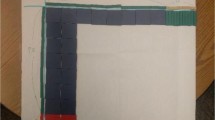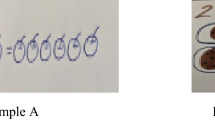Abstract
A task-based written survey was administered to 69 pre-service teachers (PSTs) at a large Midwestern University in the USA to examine their recognition of examples/non-examples of ¼ presented in various forms of the area model, their perceived mathematical key points in identifying examples/non-examples, and their instructional decisions in selecting and sequencing examples/non-examples. An inductive content analysis showed that typical examples of ¼ did not distinguish different levels of PSTs’ content knowledge. However, in cases of unconventional examples, PSTs’ levels of content knowledge were easily discernible. Also, PSTs across different performance levels perceived equal partitioning as a key mathematical point and gave it primary consideration in sequencing examples, but they interpreted “equal parts” in many different ways, and only the high-performance group incorporated unconventional examples in making a sequence. In all performance levels, the inclusion of a non-example in making a sequence was scarce. Implications for improving the teaching of fraction concepts in teacher preparation programs are discussed.


Similar content being viewed by others
References
Ashlock, R. B. (2015). Deep diagnosis, focused instruction, and expanded math horizons. In S. Chinn (Ed.), The Routledge international handbook of dyscalculia and mathematical learning difficulties (pp. 228–241). New York, NY: Routledge.
Ball, D. L. (1993). Halves, pieces, and twoths: Constructing representational contexts in teaching fractions. In T. Carpenter, E. Fennema, & T. Romberg (Eds.), Rational numbers: An integration of research (pp. 157–196). Hillsdale, MI: Erlbaum.
Ball, D. L., Hill, H. C., & Bass, H. (2005). Knowing mathematics for teaching: Who knows mathematics well enough to teach third grade, and how can we decide? American Educator, 30(3), 14–17 20–22, 43–46.
Ball, D. L., Thames, M. H., & Phelps, G. (2008). Content knowledge for teaching: What makes it special? Journal of Teacher Education, 59(5), 389–407.
Beattie, H. L., Ren, L., Smith, W. M., & Heaton, R. M. (2017). Measuring elementary. Mathematics teachers’ noticing: Using child study as a vehicle. In E. O. Schack, M. H. Fisher, & J. A. Wilhelm (Eds.), Teacher noticing: Bridging and broadening perspectives, contexts, and frameworks (pp. 321–338). Cham, Switzerland: Springer International Publishing.
Boaler, J. (2016). Mathematical mindsets: unleashing students’ potential through creative math, inspiring messages and innovative teaching. San Francisco, CA: Jossey-Bass.
Ciosek, M., & Samborska, M. (2016). A false belief about fractions - what is its source? The Journal of Mathematical Behavior, 42, 20–32.
Cramer, K., & Whitney, S. (2010). Learning rational number concepts and skills in elementary classrooms. In D. V. Lambdin & F. K. Lester (Eds.), Teaching and learning mathematics: Translating research to the elementary classroom (pp. 15–22). Reston, VA: NCTM.
Dick, L. K. (2017). Investigating the relationship between professional noticing and specialized content knowledge. In E. O. Schack, M. H. Fisher, & J. A. Wilhelm (Eds.), Teacher noticing: Bridging and broadening perspectives, contexts, and frameworks (pp. 339–358). Cham, Switzerland: Springer International Publishing.
Dreher, A., & Kuntze, S. (2015). Teachers’ professional knowledge and noticing: The case of multiple representations in the mathematics classroom. Educational Studies in Mathematics, 88(1), 89–114.
Grbich, C. (2007). Qualitative data analysis: An introduction. London, England: SAGE Publications.
Huntley, R. (2013). Pre-service primary teachers’ choice of mathematical examples: Formative analysis of lesson plan data. In V. Steinle, L. Ball, & C. Bardini (Eds.), Mathematics education: Yesterday, today and tomorrow. Proceedings of the 36th annual conference of the Mathematics Education Research Group of Australasia. (pp. 394–401). Melbourne, Australia: MERGA.
Jacobs, V. R., Lamb, L. L. C., & Philipp, R. A. (2010). Professional noticing of children's mathematical thinking. Journal for Research in Mathematics Education, 41(2), 169–202.
Kidron, I., & Bikner-Ahsbahs, A. (2015). Advancing research by means of the networking of theories. In A. Bikner-Ahsbahs, C. Knipping, & N. Presmeg (Eds.), Approaches to qualitative research in mathematics education (pp. 221–232). New York, NY: Springer.
Lamon, S. (2012). Teaching fractions and ratios for understanding: Essential content knowledge and instructional strategies for teachers. New York, NY: Routledge.
Lee, M. Y. (2017). Pre-service teachers’ flexibility with referent units in solving a fraction division problem. Educational Studies in Mathematics, 96(3), 327–348.
Lee, M. Y., & Choi, B. (2017). Mathematical teacher noticing: The key to learning from Lesson Study. In E. O. Schack, J. Wilhelm, & M. H. Fisher (Eds.), Teacher noticing: Bridging and broadening perspectives, contexts, and frameworks (pp. 121–140). New York, NY: Springer.
Lee, M. Y., & Cross Francis, D. (2018). Investigating the relationship among elementary teachers’ perception about the use of students’ thinking, their professional noticing skills and their teaching practice. Journal of Mathematical Behavior, 51, 118–128.
Lee, M. Y., & Lee, J. (2019). Pre-service teachers’ perceptions of the use of representations and suggestions for students’ incorrect Use. Eurasia Journal of Mathematics, Science and Technology Education, 15(9), 1–21.
Leinhardt, G. (2001). Instructional explanations: A commonplace for teaching and location for contrast. In V. Richardson (Ed.), Handbook of research on teaching (4th ed.) (pp. 333–357). Washington, DC: American Educational Research Association.
Liz, B., Dreyfus, T., Mason, J., Tsamir, P., Watson, A., & Zaslavsky, O. (2006). Exemplification in mathematics education. In J. Novotná, H. Moraová, M. Krátká, & N. Stehliková (Eds.), Proceedings of the 30th conference of the international group for the psychology of mathematics education (Vol. 1, pp. 126–154). Prague, Czech: PME.
Mason, J. (2002). Researching your own practice: The discipline of noticing. New York, NY: Routledge.
Mason, J., & Pimm, D. (1984). Generic examples: Seeing the general in the particular. Educational Studies in Mathematics, 15(3), 277–290.
NCTM. (2014). Principles to actions: Ensuring mathematical success for all. Reston, VA: NCTM.
Olanoff, D., Lo, J., & Tobias, J. (2014). Mathematical content knowledge for teaching elementary mathematics: A focus on fractions. The Mathematics Enthusiast, 11(2), 267–310.
Rosli, R., Han, S., Capraro, R., & Capraro, M. (2013). Exploring preservice teachers’ computational and representational knowledge of content and teaching fractions. Research in Mathematical Education, 17(4), 221–241.
Rowland, T. (2008). The purpose, design, and use of examples in the teaching of elementary mathematics. Educational Studies in Mathematics, 69(2), 149–163.
Rowland, T., Thwaites, A., & Huckstep, P. (2003). Novices’ choice of examples in the teaching of elementary mathematics. In A. Rogerson (Ed.), Proceedings of the international conference on the decidable and the undecidable in mathematics education (pp. 242–245). Czech: Brno.
Sherin, M., Jacobs, V., & Philipp, R. (Eds.). (2011). Mathematics teacher noticing: Seeing through teachers’ eyes. London, England: Routledge.
Shulman, L. S. (1986). Those who understand: Knowledge growth in teaching. Educational Researcher, 15(2), 4–14.
Skemp, R. R. (1971). The psychology of learning mathematics. Harmondsworth, England: Penguin Books, Ltd..
Steffe, L. P., & Olive, J. (2010). Children’s fractional knowledge. New York, NY: Springer.
Stoddart, T., Connell, M., Stofflett, R., & Peck, D. (1993). Reconstructing elementary teacher candidates’ understanding of mathematics and science content. Teaching and Teacher Education, 9(3), 229–241.
van de Walle, J., Karp, K. S., & Bay-Williams, J. M. (2013). Elementary and middle school mathematics: teaching developmentally (8th ed.). NJ: Pearson.
Watson, A., & Mason, J. (2002a). Extending example spaces as a learning/teaching strategy in mathematics. In A. Cockburn & E. Nardi (Eds.), Proceedings of PME 26 (Vol. 4, pp. 378–385). UK: University of East Anglia.
Watson, A., & Mason, J. (2002b). Student-generated examples in the learning of mathematics. Canadian Journal of Science, Mathematics and Technology Education, 2(2), 237–249.
Yang, Y., & Ricks, T. E. (2013). Chinese lesson study: Developing classroom instruction through collaborations in school-based teaching research group activities. In Y. Li & R. Huang (Eds.), How Chinese teach mathematics and improve teaching (pp. 51–65). New York, NY: Routledge.
Zaslavsky, O., & Zodik, I. (2007). Mathematics teachers’ choices of examples that potentially support or impede learning. Research in Mathematics Education, 9, 143–155.
Zhang, X., Clements, M. A., & Ellerton, N. F. (2015). Conceptual misunderstandings of fractions: From area models to multiple embodiments. Mathematics Education Research Journal, 27, 233–261.
Author information
Authors and Affiliations
Corresponding author
Rights and permissions
About this article
Cite this article
Lee, M.Y., Lee, JE. Pre-service Teachers’ Selection, Interpretation, and Sequence of Fraction Examples. Int J of Sci and Math Educ 19, 539–558 (2021). https://doi.org/10.1007/s10763-020-10062-0
Received:
Accepted:
Published:
Issue Date:
DOI: https://doi.org/10.1007/s10763-020-10062-0




